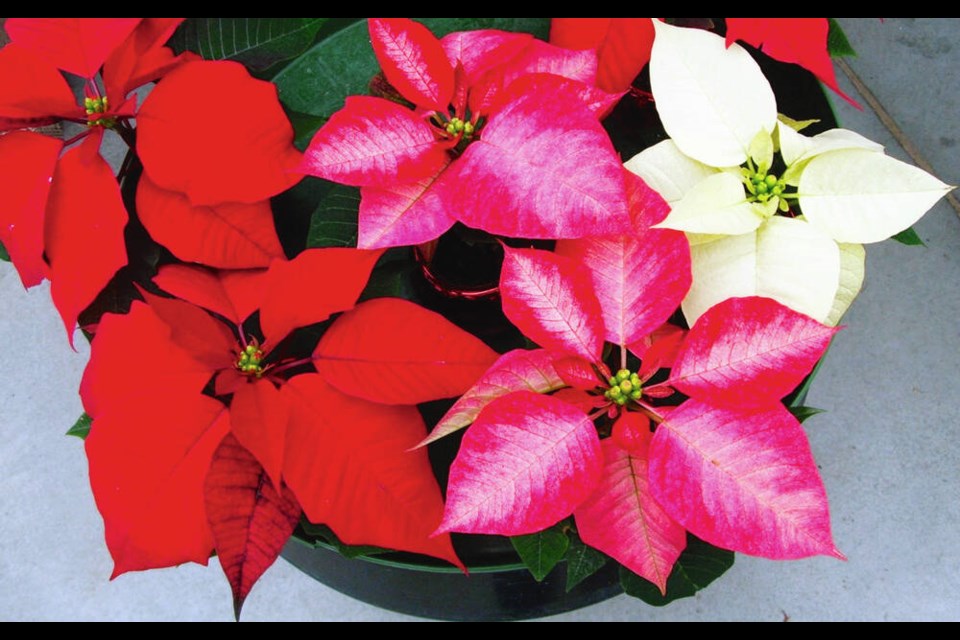Dear Helen: My gift poinsettia is dropping leaves. What to do?
E.P.
A small amount of leaf drop often occurs as the plant adjusts to a new environment. To prevent a poinsettia from losing a significant number of leaves, check that its location is in bright light and even, slightly cool room temperatures. Around 18 C is ideal.
Water when the soil feels dry and the pot feels light when lifted. Inadequate moisture, extremes of heat or cold, and hot or cold drafts are common causes of leaf drop in poinsettias.
Dear Helen: I have a peony that I think needs moving. It has been declining in both leafy growth and flower production over the past few years. When is the best time to dig and replant?
P.F.
Peonies can remain in robust health and fine flowering condition for many years in ideal conditions: full or nearly full sun, a deep, fertile, humus-rich soil that is moist but well-drained. Plants in decline usually indicate too much shade, drought, poor drainage, an impoverished soil, or/and root competition from trees or shrubs.
Poor or no bloom production in a peony can also be caused by too deep a soil cover over the crown of the plant. The crown is the structure from which top growth emerges.
Even if a peony is planted at the right depth, with the reddish growth buds (“eyes”) set no deeper than five cm beneath the soil surface, mulching over time can increase the depth of soil enough to inhibit flowering. When mulching, apply the compost around, not on top of the crown.
The ideal time for digging up a peony for replanting is in October, as the foliage changes colour and begins to die back. Clip the stems away just beneath the soil surface, taking care not to damage any of the pink growth buds on he crown, and lift the clump out carefully. If the crown is broad, use a sharp knife to cut it into sections with at least three plump buds apiece.
Prepare the new planting sites ahead of time, digging the soil as deeply as possible and mixing in compost and bone meal.
Dear Helen: I’ve been reading and hearing about a drastic decline in bird and insect populations. Is there anything that a person with a garden can do help support bird and insect life?
L.N.
I’ve been following this information too, and I’m sure some of us remember the days when a road trip inevitably involved insect-spattered windshields. Not so any more.
Anyone viewing the world of insects as just a bunch of pesky bugs needs to take another look at the situation. Only one to three per cent of all insects are considered pests.
Insects perform useful services for us. They help to control pests in our gardens. They act as Nature’s sanitary engineers and fertilizing agents as they decompose plant and animal waste. The decomposition process leads to the release of nutrients into the natural environment.
Insects pollinate the food crops we require to live. They serve as food for other wildlife, including birds.
Why the alarming collapse of insect populations? Urbanization, habitat destruction, monoculture farming, pesticide use, climate change.
Home gardeners can create an inviting environment for insects by planting as wide a variety of plants as possible, and include native plants. Ground covers, leaf litter, trees, shrubs and grasses provide shelter.
Among the best flowers for attracting and feeding beneficial insects are sweet alyssum, cilantro, calendula, thyme, lavender, rosemary, and daisy type flowers. Insects need water, which can be supplied in dry weather in water-filled plant trays with pebbles for perching on.
For healthy, balanced insect life in a garden, avoid the use of pesticides.
The same causes behind insect population losses have affected birds, which are also vital to a healthy environment.
Birds pollinate plants, disperse seeds, help to control pests and are nature’s cleaners of dead animal matter. They are important environmental indicators. Population losses point to declining health in the environment and reduction in biodiversity.
Most birds need trees, shrubs and vines to nest in. Sunflowers and other seed-bearing plants help to keep them fed. Snowberry, Oregon grape, salal, flowering currant and huckleberry provide more favourite foods for birds. Shallow bird feeders, kept clean, provide the water they need.
Avoiding the use of pesticides is crucial for protecting both birds and insects.
Happy New Year to all. May you celebrate your way safely into 2022.



